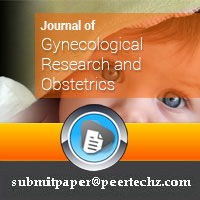Journal of Gynecological Research and Obstetrics
Impact of coronavirus pandemic on cancer patients; is it time for ectoine and/or ACE inhibitors?
Eman El-Abd*
Cite this as
Abd EE (2020) Impact of coronavirus pandemic on cancer patients; is it time for ectoine and/or ACE inhibitors? J Gynecol Res Obstet 6(1): 002-003. DOI: 10.17352/jgro.000075Cancer patients require attention after COVID-19. ACEI and/or ectoine could represent potential adjuvant therapy. Clinical trials are required to investigate this hope to mitigate COVID-19 infectivity and cell invasion.
Problem magnitude
In 2018, globocan reported 18,078,957 new cancer cases and 9,555,027 total deaths from cancer worldwide [1]. During coronavirus pandemic (total confirmed cases 191,127 and 7,807 of total deaths, globally; situation report-58), it is crucial to pay attention to immunosuppressed cancer patients especially, who are on recent active treatment. Qin, et al. [2], reported immune dysregulation in COVID-19 affected patients. Analysis of 2007 confirmed COVID-19 cases from 575 Chinese hospitals revealed that patients with cancer (18 patients) deteriorated more rapidly than those without cancer (13 days versus 43 days; p < 0.0001) [3]. Cancer patients had elder age, smoking history, abnormality in CT-scan, and polypnea. Risk factors for sever events in COVID-19 patients included age, female gender, cancer, hypertension, COPD, and diabetes mellitus [3].
Evidence-based suggested adjuvant therapy
ACE-2 receptor and serine protease TMPRSS2 are detrimental for infectivity of COVID-19 [4,5]. Thus camostat, and ACEI were suggested as possible potential treatments for COVID-19 [6]. Additionally, based on the molecular biology of the virus, Cepharanthine (CEP), selamectin and mefloquine hydrochloride were suggested as potential therapeutics for COVID-19 [6]. However, ACEI and angiotensin receptor blockers were hypothesized to modulate sever effects of COVID-19 and raised more concerns or patients with other comorbidities [6,7].
Minimal invasive autopsy of three COVID-19 cases revealed significant inflammatory response in lungs and tissue damage in other organs including heart, liver and kidney [8]. Tian, et al. [9], also reported inflammatory lung response in two cases who underwent lung lobectomies for adenocarcinoma. Ectoine, a compatible Solute with no detectable cytotoxicity so far, proven to modulate the inflammatory response in lungs [10-13] and would prove potential adjuvant therapy for COVID-19.
Conclusion
Contradictory results were obtained from testing ACEI in oncology while no toxicity and promising results were achieved using ectoine. Clinical trials are required to test the validity of these drugs to attenuate the COVID-19 sever events.
- Ferlay J, Ervik M, Lam F, Colombet M, Bray F, et al. (2018) Cancer Incidence in Five Continents. CI5plus: IARC Cancer Base. France: International Agency for Research on Cancer. Link: https://bit.ly/350bkDt
- Qin C, Zhou L, Hu Z, Zhang S, Yang S, et al. (2020) Dysregulation of immune response in patients with COVID-19 in Wuhan, China. Clinical Infectious Diseases. Link: https://bit.ly/34YYG7w
- Liang W, Guan W, Chen R, Wei W, Li J, et al. (2020) Cancer patients in SARS-CoV-2 inection: a nationwide analysis in China. Lancet Oncol 21: 335-337. Link: https://bit.ly/34WK094
- Hoffmann M, Kleine-Weber H, Schroeder S, Krüger N, Herrler T, et al. (2020) SARS-CoV-2 cell entry depends on ACE2 and TMPRSS2 and is blocked by a clinically proven protease inhibitor. Cell 181: 270-280.e8. Link: https://bit.ly/3eLBmin
- Chen Y, Guo Y, Pan Y, Zhao ZJ (2020) Structure analysis of the receptor binding of 2019-nCoV. Biochem Biophys Res Commun pii: 525: 135-140. Link: https://bit.ly/3bBaOhG
- Thomson G (2020) COVID-19: social distancing, ACE 2 receptors, protease inhibitors and beyond? Int J Clin Pract e13503. Link: https://bit.ly/2Y57BTP
- Diaz JH (2020) Hypothesis: angiotensin-converting enzyme inhibitors and angiotensin receptor blockers may increase the risk of severe COVID-19. J Travel Med pii: taaa041. Link: https://bit.ly/2x0wJzK
- Yao XH, Li TY, He ZC, Ping YF, Liu HW, et al. (2020) A pathological report of three COVID-19 cases by minimally invasive autopsies. Zhonghua Bing Li Xue Za Zhi 49: E009. Link: https://bit.ly/3aAkGGZ
- Tian S, Hu W, Niu L, Liu H, Xu H, et al. (2020) Pulmonary pathology of early-phase 2019 Novel Coronavirus (COVID-19) pneumonia in two patients with Lung Cancer. J Thorac Oncol pii: S1556-0864(20): 30132-30135. Link: https://bit.ly/3eI6U8E
- Sydlik U, Peuschel H, Paunel-Görgülü A, Keymel S, Krämer U, et al. (2013) Recovery of neutrophil apoptosis by ectoine: a new strategy against lung inflammation. Eur Respir J 41: 433-442. Link: https://bit.ly/2zhfmeK
- Unfried K, Kroker M, Autengruber A, Gotić M, Sydlik U (2014) The compatible solute ectoine reduces the exacerbating effect of environmental model particles on the immune response of the airways. J Allergy 2014: 708458. Link: https://bit.ly/3eJDIOM
- Unfried K, Krämer U, Sydlik U, Autengruber A, Bilstein A, et al. (2016) Reduction of neutrophilic lung inflammation by inhalation of the compatible solute ectoine: a randomized trial with elderly individuals. Int J Chron Obstruct Pulmon Dis 11: 2573-2583. Link: https://bit.ly/2VOpYtn
- Tran BH, Dao VA, Bilstein A, Unfried K, Shah-Hosseini K, et al. (2019) Ectoine-containing inhalation solution versus saline inhalation solution in the treatment of acute bronchitis and acute respiratory infections: A prospective, controlled, observational study. Biomed Res Int 2019: 7945091. Link: https://bit.ly/3ePNleT
Article Alerts
Subscribe to our articles alerts and stay tuned.
 This work is licensed under a Creative Commons Attribution 4.0 International License.
This work is licensed under a Creative Commons Attribution 4.0 International License.

 Save to Mendeley
Save to Mendeley
